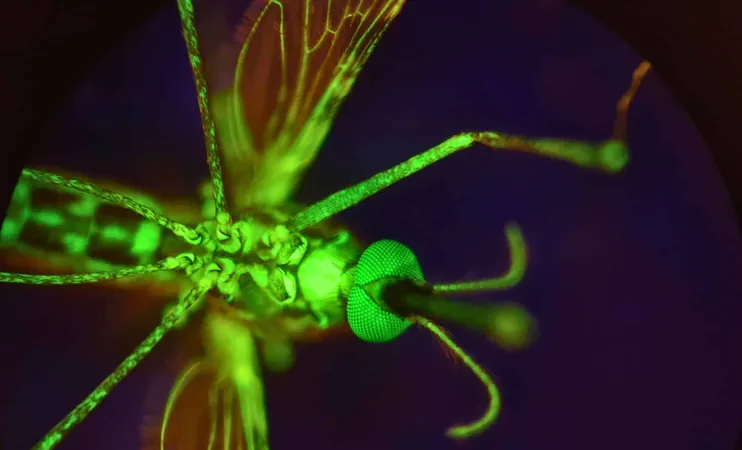
Shocking New Method to Combat Malaria: Researchers Use Human Blood to Poison Mosquitoes!
2025-04-03
Author: Lok
Malaria remains a tenacious foe, claiming over 600,000 lives globally each year, despite concerted global health efforts. However, a groundbreaking approach emerged that could redefine malaria control—using a repurposed drug that transforms human blood into a deadly substance for mosquitoes, the primary vectors of the disease.
In a remarkable study published in Science Translational Medicine, scientists unveiled that nitisinone, a medication originally conceived decades ago, can kill mosquitoes within hours of their feeding on blood treated with even minuscule doses of the drug. This innovative strategy doesn’t offer direct protection to individuals from malaria but aims to significantly reduce mosquito populations, thereby curbing the disease's transmission.
Blood Turns Deadly for Mosquitoes
The research shows that low doses of nitisinone can effectively convert human blood into a lethal weapon against mosquitoes. After consuming treated blood, these pests succumb within hours. Astonishingly, the drug maintains its potency in the bloodstream for up to 16 days, presenting an intriguing option for breaking the transmission cycle of malaria.
Instead of offering individual immunity, this method evokes the concept of herd immunity; its efficacy hinges on broad community involvement in preventative measures. Experts warn, however, that nitisinone should not be viewed as a standalone remedy but as part of a multifaceted approach alongside bed nets, insecticides, and malaria vaccines. This could be especially crucial in regions where mosquitoes have already developed resistance to traditional insecticides.
From Herbicide to Life-Saving Treatment
The journey of nitisinone is fascinating. Initially developed as an herbicide derived from a natural toxin in the Australian bottlebrush plant, it was later discovered to be effective for treating significant human metabolic disorders like tyrosinemia type I and alkaptonuria—conditions that result when the body struggles to metabolize tyrosine, an essential amino acid. Approved by the U.S. Food and Drug Administration (FDA) in 1992, nitisinone has since become a critical treatment for affected children.
With potential side effects in high doses for treating these metabolic disorders, researchers are excited to find that much smaller quantities can have lethal effects on malaria-spreading mosquitoes.
Uncovering Mosquito Vulnerabilities
The novel application of nitisinone on blood-sucking insects has roots in a 2016 discovery in Brazil by researchers Marcos Sterkel and Pedro Oliveira, who identified that mosquitoes, flies, and fleas rely on tyrosine metabolism to digest their blood meals. The inhibition of this metabolic pathway leads to their demise—a breakthrough that led to collaboration with Acosta Serrano’s lab, which previously researched tsetse flies.
Given nitisinone's pre-existing FDA approval, the drug may navigate regulatory pathways more efficiently for this new purpose. It has proven safe for use in newborns, children, and pregnant women—factors that add to its appeal as a public health tool against malaria.
Navigating Challenges Ahead
While excitement surrounds this pioneering research, experts emphasize the reality of challenges. George Dimopoulos, a molecular biologist at the Johns Hopkins Bloomberg School of Public Health, points out the potential for nitisinone to have milder side effects compared to ivermectin, another drug historically used for reducing malaria transmission.
Cost remains a significant obstacle since nitisinone is currently priced based on its use for rare conditions. Acosta Serrano posits that with heightened interest, production costs could decrease substantially. However, the drug's indirect protection model may pose hurdles for public acceptance—people might hesitate to use a medication that doesn’t directly shield them from malaria.
Exploratory avenues are being investigated for drug delivery, such as administering it to livestock that attract mosquitoes, or using insecticide-laden nectar bags designed to allure mosquitoes while preserving other beneficial pollinators. These innovations imply that nitisinone might be integrated effectively without directly involving human patients in its application.
Despite the inherent risk of resistance developing over time, both researchers agree that nitisinone holds potential as a critical element in a diversified, community-specific strategy for malaria control. The fight against this deadly disease just took a fascinating turn, one that blends human health with ecological strategies against one of the world's oldest adversaries.

 Brasil (PT)
Brasil (PT)
 Canada (EN)
Canada (EN)
 Chile (ES)
Chile (ES)
 Česko (CS)
Česko (CS)
 대한민국 (KO)
대한민국 (KO)
 España (ES)
España (ES)
 France (FR)
France (FR)
 Hong Kong (EN)
Hong Kong (EN)
 Italia (IT)
Italia (IT)
 日本 (JA)
日本 (JA)
 Magyarország (HU)
Magyarország (HU)
 Norge (NO)
Norge (NO)
 Polska (PL)
Polska (PL)
 Schweiz (DE)
Schweiz (DE)
 Singapore (EN)
Singapore (EN)
 Sverige (SV)
Sverige (SV)
 Suomi (FI)
Suomi (FI)
 Türkiye (TR)
Türkiye (TR)
 الإمارات العربية المتحدة (AR)
الإمارات العربية المتحدة (AR)